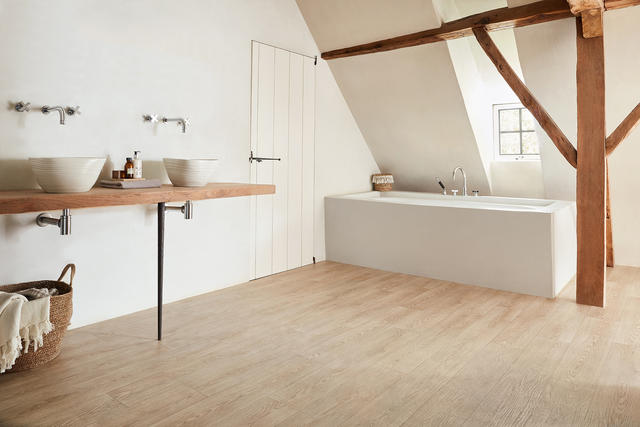
Choosing wood floors for a bathroom
Due to the challenges of water and humidity, wood flooring is not recommended for bathrooms. Even engineered hardwood, which is better at dealing with moisture and humidity than solid wood, isn’t recommended for the bathroom.
There are alternative types of flooring that are better suited to moisture-prone rooms such as the bathroom, and these will save you a lot of stress in the long-term. You won’t need to worry about potential problems arising from the effect of moisture and humidity on your wood floors, or the need for ongoing maintenance.
However, if your heart is set on wood flooring for the bathroom, a compromise would be to install one of the higher-end wood-look floors such as luxury vinyl tile (LVT). LVT is a type of vinyl flooring that is designed to imitate natural flooring options such as hardwood. However, because it’s vinyl, you won’t have to worry about its ability to deal with high levels of moisture and humidity. LVT is water-resistant, very easy to clean, and comfortable and warm underfoot. And thanks to technological advances in the manufacturing and design of vinyl, LVT is almost indistinguishable from real wood floors.
Drawbacks of wood flooring in bathrooms
Cons of using wood flooring in the bathroom
• Limited protection against moisture
• Expensive to replace in case of water damage
• Requires ongoing maintenance
Limited protection against moisture – The big disadvantage of using wood flooring in the bathroom is to do with wood’s inability to deal with water.
Expensive to replace in case of water damage – If water does get through your floor’s top coating and into your wooden floors, your wooden floors will start to rot. The increased moisture in the floors combined with the humidity in the room could also lead to the growth of mould and mildew.
Requires ongoing maintenance – You’ll need to quickly wipe up standing water, splashes and pick up damp towels from the floor. In a bathroom, you’ll also need to reinforce the sealant on your hardwood floor periodically to minimise the risk of water penetrating through the top layer.